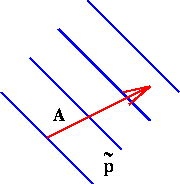These are tensors of type 0/1 and they map four- vectors into
the reals. They are denoted by ![]() , so
, so
![]() is a real
number. One- forms form a vector
space since
is a real
number. One- forms form a vector
space since
![]()
It is called the dual vector space to distinguish it from the space of
four- vectors.
The components of ![]() are
are
![]() .
We can write
.
We can write
![]()
Generally we have
![]()
Note that the signs are positive [ c.f
![]() ].
We can think of vectors as columns and one- forms as rows:
].
We can think of vectors as columns and one- forms as rows:

![]() is more fundamental than
is more fundamental than ![]() since the latter is defined only if there is a metric i.e.
since the latter is defined only if there is a metric i.e. ![]() .
.
Now let us look at how one- forms transform :


Figure 3.1: ![]() is the number of surfaces the vector
is the number of surfaces the vector ![]() pierces.
pierces.
So one- forms transform like basis vectors, not like vector components.
Now since

we have
![]()
so ![]() is frame independent.
is frame independent.
We can introduce a one- form basis
![]() , so that
, so that
![]()
Then
![]()
so we must have
![]()
This gives the basis for one- forms. It is said to be dual to
![]() .
.
One can show that
![]()
so the basis one- forms transform like vector components [ as required notationally ] .
Both vectors and one- forms have four components but they have different
geometrical interpretation. Vectors are like arrows but one- forms can be
thought of as like three dimensional surfaces with the spacing between the
surfaces defining the magnitude of ![]() [ see Figure 3.1 ].
[ see Figure 3.1 ].